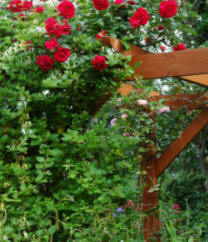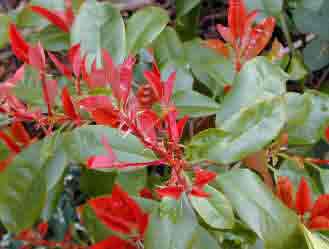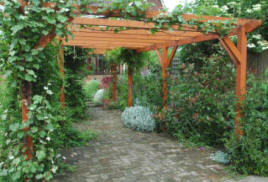Building a Pergola. Easy to follow steps on How to Build a Pergola
Many good garden centres, and a few online garden stores will have ready made pergola kits available. However if you want a good sturdy framework for plants, hanging baskets, and the like, then you will stand a better chance if you build your own pergola - custom made for your own requirements.
If you are capable of carrying out the work required to erect a ready-made kit, you should be able to build your own pergola with timber from your local timber stockist.
You WILL need basic DIY skills - and also a little help from a friend once you get round to the actual erection of your own timber garden pergola.
Type of Timber for DIY Pergolas

Our suggestion would be to use 100x100mm (4x4in) posts for the uprights, and then with main support beams of 160x50mm (6x2in) main beams, which in turn would be the support rail for either 100x50mm (4x2in) or 125x500mm (5x2in) 'rafters'.
The width of the span would determine the thickness of the rafters. For the pergola to gave a 3m span, then 100 x 50mm (4x2in) timber for the rafters would be adequate. If the span of the pergola is more than 3m, then consider 125 x 50mm (5x2in) timbers for the pergola 'roof'.
It is possible to build a basic rectangular pergola, have it free standing, attached to the house, an L shaped pergola or basically any shape you wish - providing you think in straight lines. It is also possible to give your pergola a 'curved' look with a bit of trickery - as we will explain.
Types of Tools Required.
Normal basic woodworking tools will be required - together with the skills to use them. These will include a good sharp saw. It is worth getting a new hardpoint saw for a few pounds to do this project, for you will be cutting fairly substantial sections of timber for your sturdy pergola. A screwdriver - electric or otherwise - a hammer and woodworking square. If you are going to 'notch' your pergola cross sections, then you will also need a wide woodworking chisel. A sturdy workbench or table will also be useful.
Electrical saws will make the work much easier - but care should be taken when using these - as with all tools. A good Jigsaw will be useful for cutting shapes into the ends of the protruding timbers, but should not be used for general cross cut use. Either a bench mounted circular saw or hand held electrical circular saw.
If you are an avid DIY enthusiast, you will probably have these tools, but if not, most hire shops will rent them out for a few ponds for a couple of days!
This should whet your appetite!
Or perhaps these!
Rigidity
The most important thing to remember when building a pergola, is the fact that it is the angled bracing struts that determine how rigid your structure will be - not how deep you sink your posts into the ground! It is quite possible to build a pergola as big as the one shown in the main picture, simply by supporting the posts with metaposts sunk into the ground. It is even possible to stabilise a pergola that is simply stood on a paved surface! Providing that the structure is braced in both directions, then the desired stability is guaranteed.
 Notching
of the rafter timbers is optional, depending upon how you want your
pergola to look. Every notch cut out will weaken the structure! The
pergola above, has neither notched rafters, nor bracing. In this
instance the pergola was stabilised by sunken posts, braced by the
sturdy decking. As can be seen, two sturdy M12 galvanised bolts have
been used to fasten the 150 x 50mm beams to each post. The beams then
support 125 x 50 (5x2) rafters which were double screwed at an angle
from the top - using 75mm (3in) exterior grade screws.
Notching
of the rafter timbers is optional, depending upon how you want your
pergola to look. Every notch cut out will weaken the structure! The
pergola above, has neither notched rafters, nor bracing. In this
instance the pergola was stabilised by sunken posts, braced by the
sturdy decking. As can be seen, two sturdy M12 galvanised bolts have
been used to fasten the 150 x 50mm beams to each post. The beams then
support 125 x 50 (5x2) rafters which were double screwed at an angle
from the top - using 75mm (3in) exterior grade screws.
Fixings
All metal fixings - bolts, coach screws, nails or timber screws - should be galvanised/zinc coated, and exterior grade. main beams are always best secured to posts by using bolts with large washers right the way through both timbers. Any protruding thread sections can soon be sawn off with hacksaw. Do not use screws or coach screws in this section of the pergola.
All cuts should be treated with a good exterior grade timber preservative. Apply it in at least two applications - allowing the previous one to soak right into the timber before re-applying.
Details of Pergola Fixings and supports
When Tanalised timber is used, the initial appearance is light green/brown. This soon tones down to a honey brown within a few weeks of sunshine. Thereafter it will mature to a light grey shingles colour - over a couple of years. If you decide that you would like the pergola to be a different colour (Not blue please!), then there is no need to use a coloured preservative - simply a good quality timber stain. Once your pergola is clothed in plants, the colour is secondary. It is the building of the pergola that is important.
Pergola Plans to follow | Top Ten climbing Plants | Climbing Roses |
Best Selling Gardening Products
Popular Gardening Sections

Problems
Identify Weeds in The Garden - How to deal with weeds. Diseases and Pest which harm your garden and plants, learn how to prevent, deter and erradicate your garden problems.
Garden Problems
Pruning
Pruning Guide. Shrubs flower better with correct pruning. Many illustrations and examples of what to do - and when. Includes evergreens, roses, flowering shrubs, spring flowering shrubs and pruning for stem effect. This is our most viewed and comprehensive section,
Pruning
Gardening Businesses
Gardening Businesses listed in the UK counties and USA states. County and State Listings of businesses involved in Garden supplies and services. If you wish to be added to the Directory, please send us your information. Having problems, use the search box
Businesses
Gardening
In this section you will learn about Gardening Basics, Containers, Landscaping, Propagation and Soil.
Gardening
Gardening Gifts
Gardening Gifts and Reviews, Read Before you Buy
- Gardening Gifts Ideas
- Gifts For Her
- Gifts For Men
- Power Tool Gifts
- Cheap Gifts
- Personalised Gifts
- Wildlife Gifts
- Family Gifts










